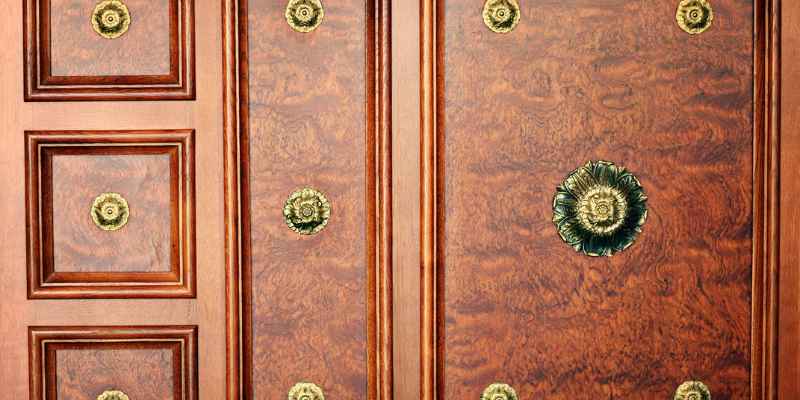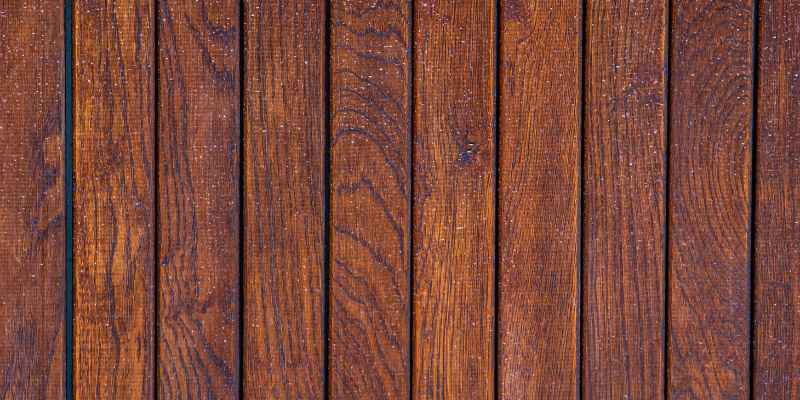Mahogany and cherry wood are both reddish in color, but mahogany has straight grain while cherry wood has a curly grain. Despite their similarities in strength and smooth finish, mahogany and cherry wood differ in appearance due to their grain patterns.
Mahogany tends to have a more orange tint and can have brownish streaks, whereas cherry wood leans towards purplish-brown tints with a delicate pattern. Both types of wood are popular in furniture making and each has its own unique characteristics that can add beauty and style to any design.
We will take a closer look at the differences between these two types of wood and explore their features, benefits, and uses in the world of woodworking.
Appearance
Mahogany and cherry wood have similarities in terms of color, strength, and durability. However, there are differences between these two woods. Mahogany is a reddish-brown wood with a straight grain, while cherry is a lighter reddish-brown wood with a curly grain.
When it comes to choosing the perfect wood for your furniture, appearance plays a crucial role. Mahogany and cherry are two popular options, both known for their warm and rich colors. In this article, we will delve into the appearance of both woods, including the color and grain pattern of each.
Color of Mahogany Wood
Mahogany is known for its reddish-brown hue that is often described as warm. It has an orange tint that can include occasional brownish streaks. The color of mahogany wood can deepen over time with exposure to sunlight. The rich color of mahogany is often associated with luxury, making it a popular option for high-end furniture.
Color of Cherry Wood
Cherry wood has a lighter reddish-brown hue that is characterized by a curly grain pattern. This contributes to the wood’s distinctive appearance, as the grain pattern often varies within a single piece of wood. Cherry wood is also known to darken over time with light exposure, taking on a richer and deeper color.
Grain Pattern of Mahogany Wood
In terms of grain pattern, mahogany wood has a straight, even grain that gives it a classic appearance. The grain is sometimes interlocked, resulting in a unique pattern that adds character to the wood.
Grain Pattern of Cherry Wood
Cherry wood, on the other hand, has a more complex grain pattern. The wood often features splashes of light yellows and pinks amid the darker reddish-brown. The curly grain pattern on cherry wood is a hallmark of the species, contributing to its popularity in high-end furniture design.
In conclusion, both mahogany and cherry wood have unique and appealing appearances. While both woods share similar reddish-brown hues, mahogany has a straight grain pattern while cherry wood has a more intricate, curly pattern. The decision between the two ultimately comes down to personal preference and the desired style of the piece of furniture you are creating.
Durability

Mahogany and cherry woods are both strong and durable, but have different colors and grain patterns. Mahogany has a straight grain and reddish-brown color with orange tints and brownish streaks, while cherry has a curly grain and lighter reddish-brown color with purplish-brown tints.
Durability is a crucial factor to consider when comparing woods for your furniture. Mahogany and cherry wood are two popular choices that many homeowners debate over. In terms of durability, there are a few key differences between the two. Let’s take a closer look at the hardness of each wood, as well as their resistance to wear and tear.
Hardness Of Mahogany Wood
Mahogany wood is considered a hardwood, with a Janka hardness rating of 800 pounds-force (lbf). This means it is relatively hard and durable, making it a great option for furniture that needs to withstand daily wear and tear. Its strength also makes it more resistant to scratches and dents than softer woods such as pine or poplar. While it’s not the hardest wood out there, it’s still a solid choice for furniture that will last.
Hardness Of Cherry Wood
Cherry wood is also considered a hardwood, with a Janka hardness rating of 950 lbf. This makes it slightly harder than mahogany, making it a good option for furniture or flooring that will experience heavy use. Cherry wood also has the advantage of being more shock-resistant than mahogany, which means it is better able to withstand impact without denting or cracking.
Resistance To Wear And Tear
Both mahogany and cherry wood are known for their durability, with each having unique properties that make them good options for furniture. Mahogany’s straight grain and consistent texture make it less prone to splintering or warping, which means it will hold up better over time. Cherry wood, on the other hand, has a more irregular grain pattern, which can give it more character in furniture. However, this same characteristic can make it more prone to splintering or warping than mahogany.
In summary, both mahogany and cherry wood are durable options for furniture, each with their own unique strengths. Mahogany is slightly softer but less prone to splintering, while cherry is stronger but more susceptible to impact damage. Ultimately, the choice between the two will come down to personal preference and the specific needs of your furniture project.
Workability
Mahogany and cherry wood have similar reddish color tones and both are durable with a smooth finish. However, mahogany has a straight grain with orange tints and brown streaks while cherry wood has a curly grain with purplish-brown hues.
y wood is softer and less durable than mahogany wood. Workability of these two woods plays a crucial role in determining their viability for various woodwork equipment. Let’s explore the ease of handling mahogany and cherry wood, as well as their compatibility with woodwork equipment.
Ease Of Handling Mahogany Wood
Mahogany is a versatile wood with excellent workability, making it easy to carve, shape, and sand. It is stable, resistant to warping and shrinking, and less prone to splitting and chipping. Mahogany wood has a fine and even texture that takes well to sanding, staining, and finishing. Moreover, it is easy to glue and nail, and it holds screws firmly. Overall, mahogany wood is a popular choice for furniture, cabinetry, and musical instruments, thanks to its workability and beauty.
Ease Of Handling Cherry Wood
Cherry wood is a moderately hard wood with a straight and uniform grain. It is easy to work with, especially with hand tools. However, it can be tricky to shape and carve using power tools, as it tends to burn and tear-out. Cherry wood has a tendency to blotch when stained, so it requires careful preparation before finishing. Moreover, cherry wood is susceptible to changes in humidity and temperature, which can cause it to warp and split. Nevertheless, cherry wood is a coveted wood for its rich color and character that develop over time.
Compatibility With Woodwork Equipment
Both mahogany and cherry wood are compatible with most woodwork equipment, including saws, routers, drills, and sanders. However, mahogany wood is denser and heavier than cherry wood, so it may require more effort and power to cut and shape. Moreover, mahogany wood contains silica, which can dull tools quickly, so it requires carbide-tipped blades and bits.
On the other hand, cherry wood is softer and more forgiving than mahogany wood, but it can also prove challenging to work with due to its susceptibility to tear-out and blotching. Overall, both mahogany and cherry wood require proper tools and techniques to achieve optimal results in woodworking.
In conclusion, mahogany and cherry wood have distinctive characteristics when it comes to workability, which affect their suitability for various woodwork equipment. While mahogany wood has superior durability, stability, and workability, cherry wood has a unique color and character that make it a beloved wood for furniture and cabinetry. When choosing between these two woods, it is essential to consider their workability, as well as their aesthetic and practical properties.
Applications
Mahogany and cherry wood are both reddish in color with a smooth texture and sturdy build. However, the differences lie in their grain pattern and undertones. Mahogany has a straight grain with orange tints and brown streaks, while cherry has a curly grain with purplish-brown undertones.
Mahogany and cherry wood have distinct differences in color, texture, and durability. These qualities make each wood suitable for different applications, ranging from furniture-making to interior design. Understanding the unique characteristics of each wood can help you make informed decisions when selecting wood for your project.
Mahogany Wood Applications
Mahogany wood is a popular choice for furniture-making due to its strength and durability. Its reddish-brown color and straight grain make it an attractive choice for high-end furniture pieces like dressers, tables, and cabinets. Mahogany is also suitable for outdoor applications such as decking and boat building due to its resistance to rot and insect infestations. Additionally, its smooth finish makes it a favored choice for musical instruments such as guitars and pianos.
Cherry Wood Applications
Cherry wood is known for its light reddish-brown color and curly grain pattern, making it a popular choice for cabinetry and interior design projects. It is a softer wood than mahogany but is still durable enough to withstand years of daily use. Cherry wood is suitable for furniture pieces such as benches, cabinets, and chairs. Its intricate patterns also make it an excellent option for intricate carving and ornamental pieces, such as decorative vases.
To summarize, mahogany and cherry wood each have unique qualities that make them suitable for different applications. Mahogany is strong and durable, making it perfect for furniture and outdoor projects, while cherry is softer and loved for its intricate grain and light reddish-brown color, making it favored for cabinetry and decorative projects.
Cost Comparison

Reddish-brown color with straight grain, while cherry has a lighter reddish-brown color with a curly grain. While both are strong and durable with a smooth finish, there are distinct differences between mahogany and cherry wood in terms of color and grain pattern.
When it comes to choosing between Mahogany and Cherry wood for your furniture, it’s essential to consider the cost factor. Both woods are popular, beautiful, and durable. However, their prices differ based on several factors. In this section, we’ll discuss Mahogany and Cherry wood cost and the factors affecting their price.
Mahogany Wood Cost
Mahogany is an expensive wood species. The price of mahogany varies based on many factors, including its quality, thickness, grade, and availability. Mahogany lumber is available in different grades, and each grade has its price point. Generally, the higher the grade, the more expensive the wood. African Mahogany is more affordable than Honduran or Cuban mahogany. The cost of mahogany averages around $8 to $28 per board foot, depending on where you’re buying it from and the quality you need.
Cherry Wood Cost
Cherry wood is another premium wood choice. Like mahogany, cherry’s cost is influenced by factors like quality, thickness, availability, and grade. The cost of cherry wood averages around $7 to $16 per board foot, depending on the supplier, quality, and thickness.
Factors Affecting Price
Several factors determine the cost of Mahogany and Cherry wood. Let’s take a look at them briefly.
Quality: The grade and quality of the wood determine its cost. Higher quality wood will cost more.
Thickness: Thicker wood will cost more because it takes longer to dry and requires more material.
Availability: The availability of the wood species affects its cost. If it’s scarce, expect to pay more for it.
Location: The location you buy your wood from will also affect the price. Different regions have different prices for mahogany and cherry wood.
In conclusion
The cost of mahogany and cherry wood varies based on several factors, including their quality, thickness, availability, and grade. While mahogany and cherry wood are both premium wood species, mahogany is generally more expensive than cherry wood. It is essential to consider the cost of the wood when choosing between Mahogany and Cherry wood for your furniture projects.
Maintenance
Mahogany and cherry wood are both known for their reddish color and durability with a smooth finish. However, their differences lie in their grain – mahogany has a straight grain, while cherry has a curly grain. Overall, both types of wood can add elegance and charm to any piece of furniture with proper maintenance.
When it comes to choosing between mahogany and cherry wood, one factor that must be considered is the maintenance requirements of both woods. Although both woods are similar in color and strength, there are differences in their cleaning and polishing requirements. Let’s take a closer look at these requirements below.
Cleaning and Polishing Requirements for Mahogany Wood
Mahogany wood has a beautiful reddish-brown color that can be preserved with regular cleaning. To clean mahogany wood, simply wipe it down with a damp cloth to remove any dust or debris. Avoid using harsh chemicals or abrasive cleaners, as they may damage the wood finish. Instead, use a mild soap solution to clean stubborn stains or dirt. It is also recommended to polish mahogany wood every few months to maintain its natural luster. This can be achieved by using a commercial wood polish or a mixture of beeswax and linseed oil. Gently buff the polish onto the wood surface using a clean cloth to restore its shine.
Cleaning and Polishing Requirements for Cherry Wood
Cherry wood has a softer, lighter reddish-brown color with a curly grain pattern. To keep cherry wood looking its best, it is important to clean it regularly with a damp cloth to remove any dust or dirt. Like mahogany, avoid harsh chemicals or abrasive cleaners that may damage the wood finish. You can use a mild soap solution to remove any stubborn stains or dirt.
When it comes to polishing, cherry wood requires a slightly different approach. Instead of using a commercial wood polish, it is recommended to use a mixture of equal parts olive oil, white vinegar, and water. Apply the mixture onto the wood surface and buff it gently with a clean cloth. This will help to restore the wood’s natural shine and protect it from drying out.
In conclusion, both mahogany and cherry wood require regular cleaning and polishing to maintain their natural beauty. By following these simple cleaning and polishing requirements, you can ensure that your furniture made from mahogany or cherry wood will last for years to come. However, it is important to note that these requirements may vary depending on the specific type of wood and its finish.
Frequently Asked Questions Of Mahogany Vs Cherry Wood Color
Is Mahogany And Cherry Wood The Same Color?
Mahogany and cherry wood are not exactly the same color, although they both share a reddish-brown hue and a smooth finish. Mahogany leans towards orange tints and can have brownish streaks, while cherry leans towards purplish-brown tones and has a delicate pattern.
Additionally, mahogany has a straight grain, while cherry has a curly grain.
Does Mahogany And Cherry Go Together?
Yes, mahogany and cherry can go together as they both have warm undertones and a reddish-brown color, but with some noticeable differences. Mahogany has a straight grain while cherry has a curly grain. Mahogany leans towards orange tints and brownish streaks, while cherry leans more towards purplish-brown tints and has a delicate pattern.
Ultimately, it depends on personal preference and the overall look and feel of the space.
Which Wood Is More Expensive Cherry Or Mahogany?
Mahogany wood is slightly more expensive than cherry wood due to its rarity and higher demand. Both woods have a reddish-brown color, but mahogany has more orange tints and can have brownish streaks, while cherry has purplish-brown tints with a delicate grain pattern.
The cost of both woods may vary depending on the supplier.
What Does Mahogany Wood Color Look Like?
Mahogany wood color is reddish-brown with some orange tints and brownish streaks. Although they are similar, cherry wood leans toward purplish-brown tints and has a delicate pattern. Both are strong and durable, with a smooth finish, but they differ in grain and color.
Conclusion
Mahogany and cherry woods share some similarities in terms of reddish-brown color and durability. However, they differ in their grain patterns, with mahogany having a straight grain and cherry having a curly grain. When it comes to cost, mahogany can be more expensive than cherry.
Ultimately, the choice between these wood types will depend on personal preferences and the desired aesthetic outcome. Consider the characteristics of both woods carefully before making a decision.


